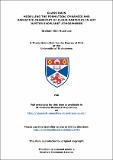Files in this item
Glass rain : modelling the formation, dynamics and radiative-transport of cloud particles in hot Jupiter exoplanet atmospheres
Item metadata
| dc.contributor.advisor | Helling, Christiane | |
| dc.contributor.author | Lee, Graham Kim Huat | |
| dc.coverage.spatial | [xii], 139, [7] p. | en_US |
| dc.date.accessioned | 2017-09-25T15:23:49Z | |
| dc.date.available | 2017-09-25T15:23:49Z | |
| dc.date.issued | 2017-12-07 | |
| dc.identifier | uk.bl.ethos.722988 | |
| dc.identifier.uri | https://hdl.handle.net/10023/11740 | |
| dc.description.abstract | The atmospheres of exoplanets are being characterised in increasing detail by observational facilities and will be examined with even greater clarity with upcoming space based missions such as the James Webb Space Telescope (JWST) and the Wide Field InfraRed Survey Telescope (WFIRST). A major component of exoplanet atmospheres is the presence of cloud particles which produce characteristic observational signatures in transit spectra and influence the geometric albedo of exoplanets. Despite a decade of observational evidence, the formation, dynamics and radiative-transport of exoplanet atmospheric cloud particles remains an open question in the exoplanet community. In this thesis, we investigate the kinetic chemistry of cloud formation in hot Jupiter exoplanets, their effect on the atmospheric dynamics and observable properties. We use a static 1D cloud formation code to investigate the cloud formation properties of the hot Jupiter HD 189733b. We couple a time-dependent kinetic cloud formation to a 3D radiative-hydrodynamic simulation of the atmosphere of HD 189733b and investigate the dynamical properties of cloud particles in the atmosphere. We develop a 3D multiple-scattering Monte Carlo radiative-transfer code to post-process the results of the cloudy HD 189733b RHD simulation and compare the results to observational results. We find that the cloud structures of the hot Jupiter HD 189733b are likely to be highly inhomogeneous, with differences in cloud particle sizes, number density and composition with longitude, latitude and depth. Cloud structures are most divergent between the dayside and nightside faces of the planet due to the instability of silicate materials on the hotter dayside. We find that the HD 189733b simulation in post-processing is consistent with geometric albedo observations of the planet. Due to the scattering properties of the cloud particles we predict that HD 189733b will be brighter in the upcoming space missions CHaracterising ExOPlanet Satellite (CHEOPS) bandpass compared to the Transiting Exoplanet Space Survey (TESS) bandpass. | en_US |
| dc.language.iso | en | en_US |
| dc.publisher | University of St Andrews | |
| dc.rights | Attribution-NonCommercial-NoDerivatives 4.0 International | * |
| dc.rights.uri | http://creativecommons.org/licenses/by-nc-nd/4.0/ | * |
| dc.subject | Exoplanets | en_US |
| dc.subject | Atmospheres | en_US |
| dc.subject | Radiative-transfer | en_US |
| dc.subject | Cloud formation | en_US |
| dc.subject | Hot Jupiters | en_US |
| dc.subject | HD 189733b | en_US |
| dc.subject | Monte Carlo radiative-transfer | en_US |
| dc.subject | Global circulation models | en_US |
| dc.subject.lcc | QB820.L4 | en |
| dc.subject.lcsh | Extrasolar planets--Atmospheres--Mathematical models | en |
| dc.subject.lcsh | Cloud physics--Mathematical models | en |
| dc.subject.lcsh | Radiative transfer | en |
| dc.title | Glass rain : modelling the formation, dynamics and radiative-transport of cloud particles in hot Jupiter exoplanet atmospheres | en_US |
| dc.type | Thesis | en_US |
| dc.contributor.sponsor | European Research Council (ERC) | en_US |
| dc.type.qualificationlevel | Doctoral | en_US |
| dc.type.qualificationname | PhD Doctor of Philosophy | en_US |
| dc.publisher.institution | The University of St Andrews | en_US |
The following licence files are associated with this item:
This item appears in the following Collection(s)
Except where otherwise noted within the work, this item's licence for re-use is described as Attribution-NonCommercial-NoDerivatives 4.0 International
Items in the St Andrews Research Repository are protected by copyright, with all rights reserved, unless otherwise indicated.


